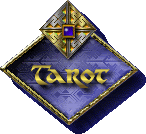


There are essentially two types of tarot decks:
|
The first is sequential as previously mentioned. The Major Arcana
is laced with images and symbols, with Minor Arcana strongly
resembling a conventional playing card deck. For a very long
time, the Swiss Deck would be the starter for many novices of
divination. Its Germanic woodcut style and French captions truly
make one wonder when it first came to be. |
|
|
The second type features each card with its own symbols. This
style was introduced at the turn of the previous century by
mystic and author Arthur Edward Waite. He commissioned artist
Pamela Colman Smith to design each Minor Arcana card with unique
symbols and imagery. This deck - called
Rider-Waite - has since become very popular among novices, giving
them the opportunity to identify the scenarios of each card key
with their intended meaning. |

Since the inception of the Rider-Waite deck in the early 20th century, there has been a discrepancy in the order of the Major Arcana. Before then, card key 8 was assigned to Justice and card key 11 was Strength. The Rider-Waite deck transposes the order of these two cards for some reason.
To this day, these conflicting orders have continued to manifest in variious decks. And although it appears that the sequential tends to continue along the lines of the old order and symbolic types follow Rider-Waite's lead, there have been exceptions. More likely, a card designer will look to an existing deck for the order.
This is no trivial issue when dealing with a medium, the emphasis of which is on minute detail. Numbers are indeed taken into account in a reading, both for a card's individual interpretation as well as how one card relates to others in a spread.
Website graphics created with love by Moyra's Web Jewels
All original content © D.David


